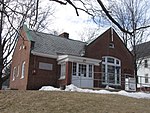Robbie Mills Field
2005 establishments in New HampshireBaseball venues in New HampshireBuildings and structures in Laconia, New HampshireMinor league baseball venuesNew England Collegiate Baseball League ballparks ... and 2 more
Sports venues completed in 2005Tourist attractions in Belknap County, New Hampshire

Robbie Mills Field is a baseball venue located in Laconia, New Hampshire, United States. It was home to the Winnipesaukee Muskrats of the collegiate summer New England Collegiate Baseball League (NECBL). The Muskrats began play there in the 2010 season. The field was built in 2005 and is named after Robbie Mills, a Laconia boy who was killed and robbed of his bicycle in 1998.Robbie Mills Field has a seating capacity of 1,200 spectators, in uncovered bleachers beyond both the first-base and third-base dugouts. There is also a small bleacher section beyond centerfield, and fans can set up their own lawn chairs beyond the outfield and behind the backstop.
Excerpt from the Wikipedia article Robbie Mills Field (License: CC BY-SA 3.0, Authors, Images).Robbie Mills Field
Meredith Center Road, Laconia
Geographical coordinates (GPS) Address Nearby Places Show on map
Geographical coordinates (GPS)
| Latitude | Longitude |
|---|---|
| N 43.567682 ° | E -71.498358 ° |
Address
Meredith Center Road 328
03246 Laconia
New Hampshire, United States
Open on Google Maps







